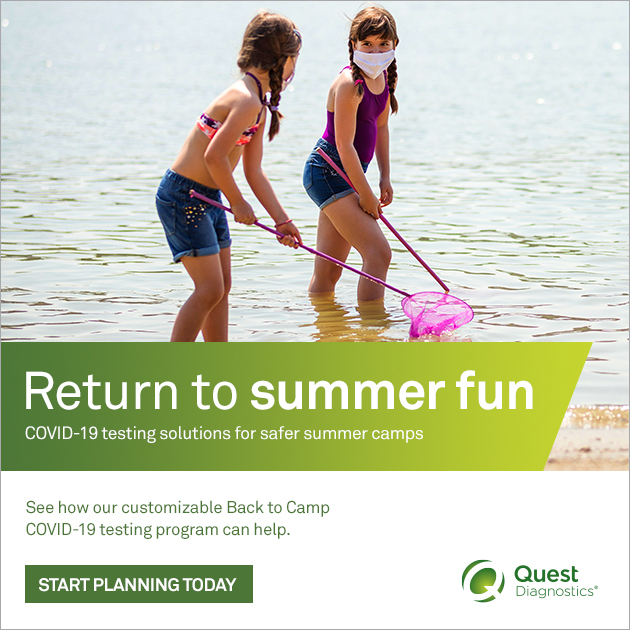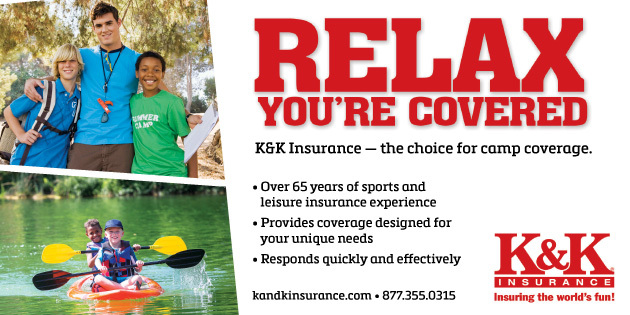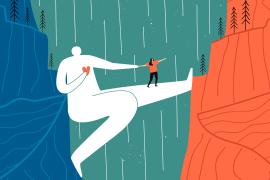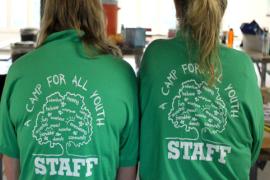Across the land, schools and summer camps have embraced a movement to better understand trauma and how it affects a child’s ability to learn and self-regulate their behavior. As that knowledge becomes available to counselors and instructors, camps have a greater ability to move from "trauma-informed" to "trauma-infused."
What does that mean for you? That frontline staff become first responders — a role that carries with it not just a serious responsibility, but also an awesome opportunity to aid young people who are experiencing the aftermath of traumatic events.
Educators Diane Wolk-Rogers and Jenna Moniz called the work a commitment to "create a safe space where our young people are invited in exactly as they are. Where they know that they belong no matter what" (Wolk-Rogers and Moniz, 2020).
That sentiment is the cornerstone of trauma-informed and trauma-infused (or trauma-responsive) education.
What to Know
According to the American Psychological Association (APA), "Trauma is an emotional response to a terrible event" (APA, 2021). Additionally, the theory of "vicarious traumatization" recognizes that such an event need not be experienced firsthand. It can also result from simply hearing about or watching media coverage of tragedy (Newport Academy, 2020).
Reporting on the outcomes of "adverse childhood experiences (ACES)," Newport Healthcare reveals the following (Newport Healthcare, 2019):
Researchers found illuminating information on how adverse childhood experiences affect physical and mental health. People with higher ACES scores were at greater risk for a wide variety of diseases and negative life events, ranging from unintended pregnancy to diabetes to depression and anxiety. For example, compared to someone with a score of zero, a person with an ACES score of 4 or higher was
- Twice as likely to smoke
- Twice as likely to have been diagnosed with cancer or heart disease
- Seven times as likely to be an alcoholic
- Six times as likely to have had sex before the age of 15
- Four times as likely to suffer from emphysema or chronic bronchitis
- Nearly five times as likely to experience depression
- Twelve times as likely to have attempted suicide
In short, ACES can be categorized as traumatic events that can have lasting effects.
Linda Ebner Erceg, RN, MS, PHN, former executive director of the Association of Camp Nursing, reports, "Seventy percent of the general population — that includes our campers and staff — have coped with at least one adverse childhood experience by the time they reach age 18.
"These events include physical, emotional, and/or sexual abuse, feeling unloved or unwanted by one’s family, being afraid that basic needs like having food and shelter won’t be met, coping with separation or divorce of caregivers, and witnessing domestic violence or having someone in the home get incarcerated. In addition, one out of six people report four or more of these happening to them" (Ebner Erceg, 2017).
Ebner Erceg goes on to share the story of one camper to illustrate the potential fallout from ACES while also emphasizing the power of counselors to connect with children. She wrote the following:
Nellie was a conundrum. She didn’t smile very readily and preferred hanging out at the edge of camper groups. She didn’t initiate conversation either; she generally waited until someone approached her. She rarely spoke to counselors and tended to do so when others weren’t around. She didn’t get excited over things like other campers. Indeed, it was challenging to get a read on what she was feeling because she seemed to disappear among the other kids.
Nellie was easy for us to overlook. She was simply an OK camper.
. . . Until one of her counselors lost it. A couple campers had pulled their last stunt; they tried the counselor's patience once too often and the counselor ended up yelling — quite sternly — at them. While the targeted campers absorbed the tirade, it was Nellie’s reaction that grabbed our attention. She literally tucked herself into a corner of the cabin, knees tightly drawn to her chest, elbows tucked to her sides with hands alternately covering her ears and wiping the tears flowing from her eyes. She cowered. It took quite a bit of gentle one-on-one talking to bring her around.
Then later, when one of her counselors checked in with her during a quiet moment, the story came out.
Nellie was from a home where parental yelling quickly gave way to hitting. She had learned not to do anything that might instigate this, not to ask questions nor request help, and to "disappear" among her siblings. The story went on.
This quiet camper had a traumatic background, one that squelched her natural curiosity in favor of seeking to exist without being noticed by others. If her counselor hadn’t taken time to check in with her, I wonder if we would have learned anything more about Nellie or what I now know as "trauma-informed care."
Some of these children may seem to be discipline problems, which makes identifying the cause behind their behavior particularly important. In his article for the George Lucas Educational Foundation, "Trauma is ‘Written Into Our Bodies’ — but Educators Can Help," Stephen Merrill shares the experiences of Nadine Burke Harris, MD, saying, "Sitting in her examination rooms back then, in one of San Francisco’s poorest neighborhoods, Burke Harris knew almost immediately that something was amiss. Her young patients arrived with tentative diagnoses of oppositional defiant disorder or learning deficits, but routine exams uncovered a host of more serious physical ailments: asthma, autoimmune hepatitis, and even growth failure. Almost inevitably, the children’s caretakers — also sick with advanced diabetes, heart disease, or cancer — relayed harrowing stories of family incarceration, sexual abuse, and even murder" (Merrill, 2020).
The good news, Burke Harris says, is that the damage is reversible. And you can help.
How to Help
Because many children and teens will experience summer camp against a backdrop of trauma, a fundamental understanding of trauma and how to alleviate its effects is important. Take a look at the "three pillars of trauma-informed care" (Weber, 2018):
- Safety: Trauma can affect children’s sense of safety and attachment. In order for recovery to take place, adults must provide children with a sense of safety. In particular, it is important to remember to be reliable, available, predictable, and honest.
- Connections: Some children who have experienced trauma may associate adults with negative emotions. In order for recovery to take place, it is important that mentors display positive emotional responses toward these children. Note that this may be difficult because the children may display challenging behavior. However, even if they are displaying challenging behavior, it is important to try and not respond harshly.
- Managing Emotions: Often children who have experienced trauma have trouble managing their emotions. One of the most important skills nonparental adults can teach children is to learn to calm themselves down when they get upset. In particular teaching children how to label their feelings, so they can process their own experiences is important. Additionally, literature suggests that it may be helpful to teach children active listening skills, since this may help them learn to be more reflective and better manage their emotions.
The "Sanctuary Model" also offers a template (NCTSN, 2008).
The Sanctuary Model, also designed to guide an organization in the development of a trauma-informed culture, offers seven dominant characteristics:
- Culture of Nonviolence — build and model safety skills and a commitment to higher goals
- Culture of Emotional Intelligence — teach and model affect management skills
- Culture of Inquiry & Social Learning — build and model cognitive skills
- Culture of Shared Governance — create and model civic skills of self-control, self-discipline, and administration of healthy authority
- Culture of Open Communication — overcome barriers to healthy communication, reduce acting-out, enhance self-protective and self-correcting skills, teach healthy boundaries
- Culture of Social Responsibility — rebuild social connection skills, establish healthy attachment relationships
- Culture of Growth and Change — restore hope, meaning, purpose
You can do all seven this summer!
In her article "Become Trauma-Informed: Add Capacity to Your MESH Toolbox," Ebner Erceg states, "When faced with trauma, people either effectively cope with it and become more resilient, or they’re overwhelmed and ineffectively respond to the situation. Their response is often a function of the individual’s coping skills and available resources. Interestingly, youth — our campers — are still in the process of developing their coping abilities. Without caring adults to coach and encourage these abilities, they may get stuck or ineffectively respond, triggering a trauma response" (Ebner Erceg, 2018).
She offers the following advice:
- Strive to understand youth development and support campers as they accomplish age-appropriate tasks.
- Maintain the capacity and skills to be supportive.
- Shape your relationship with campers so it builds connectedness.
- Shift your perspective from "What’s wrong with you?" to "What do you need?"
That last point brings us back to the subjects of behavior and discipline.
Due to the rising number of students who experience ACES, educational institutions have found it necessary to shift from a traditional model of discipline (behavior charts, time-outs, suspensions, etc.) to Conscious Discipline, an evidence- and trauma-based, social-emotional learning program created by Becky Bailey, PhD. It is a complete framework for educators, parents, and communities that encompasses four components (Bailey, 2021):
- Conscious Discipline Brain State Model
- Seven Powers for Conscious Adults
- Creating the School [Camp] Family
- Seven Skills of Discipline
Conscious Discipline promotes the vision "Patterns = Predictability = Safety = Connection = Compassion."
Component 1 shows how different brain-body states produce certain behaviors in children and in us. The brain stem represents survival where we ask, "Am I safe?" To soothe this state, we have to create safety.
The limbic system, which is the part of our brains that regulates emotion, behavior, and long-term memory, represents our emotional state where we ask, "Am I loved?" To soothe an upset emotional state, we have to create connection.
The brain’s prefrontal lobes represent our executive state. This is where we ask, "What can I learn from this?" Reflecting problem-solving and learning are higher-level functions of the brain that most people who experience trauma are not accessing, because they are constantly living in a survival state of mind. Learning this component helps anyone working with kids or teens to better understand the lack of self-regulation.
Component 2 is where the essential groundwork is laid, focusing on training adults who work with children in how to be conscious of their own reactions, biases, and approaches. By working through the big ideas behind these seven powers — perception, unity, attention, free will, acceptance, love, and intention — you can better control the way you react and respond in different situations at camp.
The next portion of Conscious Discipline focuses on Creating the Family and is based on what a healthy family model should look like.
Too often we assume that everyone knows and understands how a healthy family is supposed to interact with one another. Most trauma survivors’ perceptions of a healthy family, however, could be based on abuse or neglect. This component provides an in-depth understanding of how to create and/or focus someone’s willingness to learn impulse control and attention — which can lead to more positive emotional responses.
Impulse control is created and managed through connection. A willingness to learn is essential here — without it every interaction can become a power struggle instead of a learning opportunity. The camp family can bring children to a place of willingness through a sense of belonging. Creating a camp family reduces stress because it provides an atmosphere of caring, encouragement, and meaningful contributions.
In schools this is done with routines that include morning meetings, brain breaks, class commitments, a safe place in each room, and breathing techniques for active calming. These are easily adaptable from a school model to the camp setting.
The last component of Conscious Discipline is comprised of the Seven Skills of Discipline:
- Composure
- Encouragement
- Assertiveness
- Choices
- Empathy
- Positive intent
- Consequences
In learning these connection skills campers are able to attach their own actions and emotions to valuable life skills that will reframe their future — which is really what camp is all about.
At the End of the Day
At the end of the proverbial day — or summer — any camp’s ability to alter the trajectory of a child’s life rests principally with you. Like it or not, you will have campers who bring their ACES to camp. They are not to be feared, but rather mentored, nurtured, listened to, loved, and, hopefully, somewhat healed. The environment you create in your slice of the ecosystem that is camp can truly result in a safe space where your campers can achieve their positive potential.
Discussion Questions:
- Think of an event that occurred in your childhood that left you feeling traumatized. If you feel comfortable sharing, what helped you deal with the effects of that trauma?
- What lasting effects do you think COVID-19 will have on people even after the pandemic is over? How might that affect camp?
- How will you build connectedness with your campers so that you’ll be in a position to help those who are dealing with adverse childhood experiences?
Stephen Gray Wallace, MS Ed, is an associate research professor and president and director of the Center for Adolescent Research and Education (CARE), a national collaborative of institutions and organizations committed to increasing favorable youth outcomes and reducing risk. He is a consultant to camps on staff training, teen leadership programming, outcomes measurement, and succession planning. He has broad experience as a camp director, school psychologist, and adolescent/family counselor. Stephen is a member of the professional development faculty at the American Academy of Family Physicians and American Camp Association and a parenting expert at kidsinthehouse.com, NBC News Learn, and WebMD. He is also an expert partner at the Risk Assistance Network & Exchange (RANE) and was national chairman and chief executive officer at SADD for more than 15 years. Stephen is an award-winning writer and author of the books Reality Gap and IMPACT. Additional information about Stephen’s work can be found at StephenGrayWallace.com.
Chrissie Kahan, MS Ed, has been an educator for 18 years, was an assistant principal for 10, and is currently a lead teacher/consultant with Learn It Academic Services. She is a strong advocate for students and is special education certified. Additionally, she is an author of several books, including these books for kids: Benny Gator, which focuses on anxiety management; Angry Ana, which focuses on anger management strategies; and Catspergers, which focuses on autism. She has been featured on HLN for her book Roadmap to Navigating Your Child’s Disability, which was designed to help support families in finding diagnoses and accommodations for their child. Additional information about Chrissie’s work can be found at ckahanlearnit.wixsite.com.
(c) Summit Communications Management Corporation 2021. All Rights Reserved.
Photo courtesy of Camp Scatico, Elizaville, NY.
References
- APA. (2021). Trauma. American Psychological Association. Retrieved from apa.org/topics/trauma
- Bailey, B. (2021). Trauma informed, evidence-based and research-backed SEL best practices. Conscious Discipline. Retrieved from consciousdiscipline.com/methodology/
- Bailey, B. (2015). Conscious discipline building resilient classrooms. Ovieto, FL: Loving Guidance, Inc.
- Bath, H. I. (2008). The three pillars of trauma-informed care. Reclaiming Children and Youth, 17, 17-21.
- Ebner Erceg, L. (2018, July). Become trauma-informed: add capacity to your MESH toolbox. Camping Magazine. Retrieved from ACAcamps.org/resource-library/camping-magazine/become-trauma-informed-add-capacity-your-mesh-toolbox
- Ebner Erceg, L. (2017, May 1). Nellie’s gift: A story of trauma-informed care. Camp Connection. American Camp Association. Retrieved from ACAcamps.org/news-publications/blogs/camp-connection/nellies-gift-story-trauma-informed-care
- Echo. (2017, June 7). What do I do? Trauma-informed support for children. Retrieved from echotraining.org/trauma-informed-support-for-children/
- Merrill, S. (2020, September 1). Trauma is ‘written into our bodies’ — but educators can help. Edutopia. George Lucas Educational Foundation. Retrieved from edutopia.org/article/trauma-written-our-bodies-educators-can-help
- NCTSN. (2008, August). Sanctuary model: General information. The National Child Traumatic Stress Network. Retrieved from nctsn.org/sites/default/files/interventions/sanctuary_fact_sheet.pdf
- Newport Academy. (2020, April 17). Vicarious traumatization and its impact on teens. Empowering Teens. Restoring Families. Retrieved from newportacademy.com/resources/well-being/vicarious-traumatization/
- Newport Healthcare. (2019, November 4). How the ACE Questionnaire measures childhood and teen trauma. Empowering Teens. Restoring Families. Retrieved from newporthealthcare.com/healthcare-resources/industry-articles/ace-questionnaire/
- Weber, E. (2018, March 15). The three pillars of trauma-informed care: implications for mentoring. Summary. The Chronicle of Evidence-Based Mentoring. Retrieved from evidencebasedmentoring.org/the-three-pillars-of-trauma-informed-care-implications-for-mentoring/
- Wolk-Rogers, D. & Moniz, J. (2020, August 28). Turning crisis into opportunity: A trauma-informed return to school. Medium. Retrieved from medium.com/inspired-ideas-prek-12/turning-crisis-into-opportunity-a-trauma-informed-return-to-school-e1863eabba16




